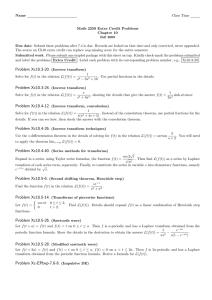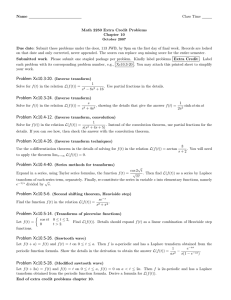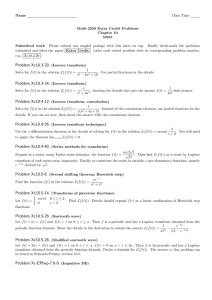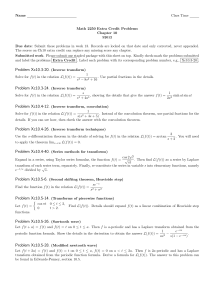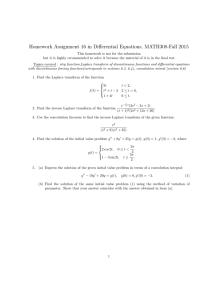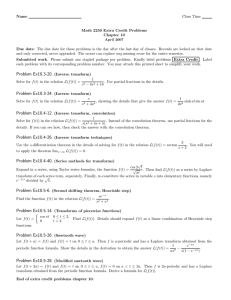Name Class Time Math 2250 Extra Credit Problems Chapter 10
advertisement
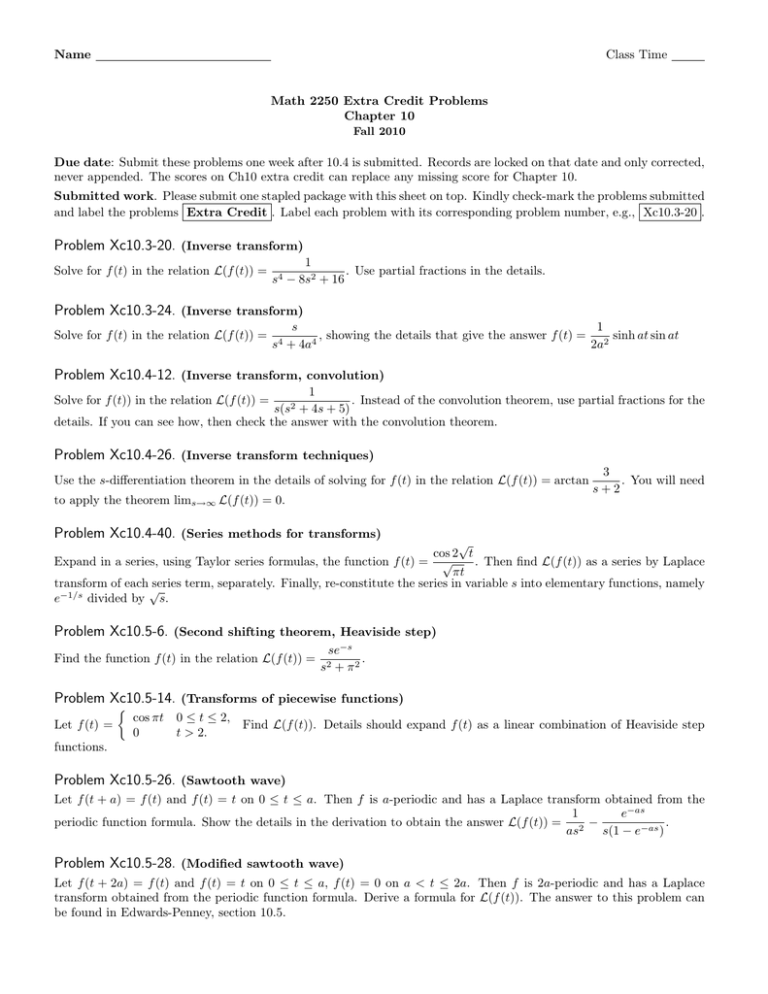
Name
Class Time
Math 2250 Extra Credit Problems
Chapter 10
Fall 2010
Due date: Submit these problems one week after 10.4 is submitted. Records are locked on that date and only corrected,
never appended. The scores on Ch10 extra credit can replace any missing score for Chapter 10.
Submitted work. Please submit one stapled package with this sheet on top. Kindly check-mark the problems submitted
and label the problems Extra Credit . Label each problem with its corresponding problem number, e.g., Xc10.3-20 .
Problem Xc10.3-20. (Inverse transform)
Solve for f (t) in the relation L(f (t)) =
1
. Use partial fractions in the details.
s4 − 8s2 + 16
Problem Xc10.3-24. (Inverse transform)
Solve for f (t) in the relation L(f (t)) =
s4
s
1
, showing the details that give the answer f (t) = 2 sinh at sin at
4
+ 4a
2a
Problem Xc10.4-12. (Inverse transform, convolution)
1
. Instead of the convolution theorem, use partial fractions for the
+ 4s + 5)
details. If you can see how, then check the answer with the convolution theorem.
Solve for f (t)) in the relation L(f (t)) =
s(s2
Problem Xc10.4-26. (Inverse transform techniques)
Use the s-differentiation theorem in the details of solving for f (t) in the relation L(f (t)) = arctan
to apply the theorem lims→∞ L(f (t)) = 0.
3
. You will need
s+2
Problem Xc10.4-40. (Series methods for transforms)
√
cos 2 t
√
. Then find L(f (t)) as a series by Laplace
πt
transform of each √
series term, separately. Finally, re-constitute the series in variable s into elementary functions, namely
e−1/s divided by s.
Expand in a series, using Taylor series formulas, the function f (t) =
Problem Xc10.5-6. (Second shifting theorem, Heaviside step)
Find the function f (t) in the relation L(f (t)) =
se−s
.
s2 + π 2
Problem Xc10.5-14. (Transforms of piecewise functions)
Let f (t) =
cos πt 0 ≤ t ≤ 2,
Find L(f (t)). Details should expand f (t) as a linear combination of Heaviside step
0
t > 2.
functions.
Problem Xc10.5-26. (Sawtooth wave)
Let f (t + a) = f (t) and f (t) = t on 0 ≤ t ≤ a. Then f is a-periodic and has a Laplace transform obtained from the
1
e−as
periodic function formula. Show the details in the derivation to obtain the answer L(f (t)) = 2 −
.
as
s(1 − e−as )
Problem Xc10.5-28. (Modified sawtooth wave)
Let f (t + 2a) = f (t) and f (t) = t on 0 ≤ t ≤ a, f (t) = 0 on a < t ≤ 2a. Then f is 2a-periodic and has a Laplace
transform obtained from the periodic function formula. Derive a formula for L(f (t)). The answer to this problem can
be found in Edwards-Penney, section 10.5.
Problem Xc-EPbvp-7.6-8. (Impulsive DE)
Solve by Laplace methods x00 + 2x0 + x = δ(t) − 2δ(t − 1), x(0) = 1, x0 (0) = 1. Check the answer in maple using
dsolve({de,ic},x(t),method=laplace) .
Problem Xc-EPbvp-7.6-18. (Switching circuit)
A passive LC-circuit has battery 6 volts and model equation i00 + 100i = 6δ(t) − 6δ(t − 1), i(0) = 1, i0 (0) = 1. The switch
is closed at time t = 0 and opened again at t = 1. Solve the equation by Laplace methods and report the number of
full cycles observed before the steady-state i = 0 is reached (to two decimal places). Check the answer in maple using
dsolve({de,ic},i(t),method=laplace) .
End of extra credit problems chapter 10.
2
